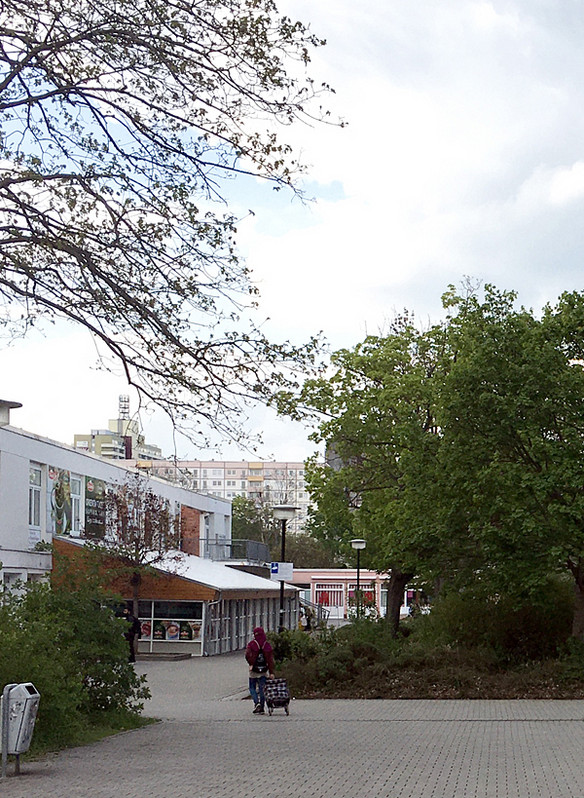Main Content
Are Open Spaces in Large Housing Estates Suitable as Places of Encounter?

Large housing estates were originally planned with their own district centres and lots of green space between the buildings. In the StadtumMig project, the Leibniz Institute for Ecological and Regional Development (IÖR) in Dresden examined the urban structures, open spaces and infrastructures of selected large housing estates in eastern Germany to see whether they still offer places for meeting, exchanging ideas and getting to know each other. It turned out that there is a lack of suitable meeting places. Especially under the impression of renewed population growth due to migration, open space planning in large housing estates is therefore facing great challenges.
In the sub-project of the IÖR within the StadtumMig project, the potentials and obstacles of appropriating public spaces were investigated. For this purpose, two perspectives on the structural-spatial situation of large housing estates were adopted: on the one hand, that of the built space with its structural, physical and functional aspects (e.g. infrastructure, residential buildings or relationships to the landscape), and on the other hand, that of the lived space based on people's everyday experience, their needs and resources. On-site mapping, online walks with local actors, interviews, document and data analysis and survey results were used.
The Initial Situation – A Lot of Green, but Little Going On
East German large housing estates are characterised by a high proportion of green space. The original urban development plans from the 1960s to 1980s already provided for large, wide green spaces. As a rule, the residential buildings are set back from the streets. As a result, there were and still are many intermediate green spaces without any real function or use. However, there were and are also variously planted front garden areas at the entrances to the buildings. In the courtyards between the row buildings there are lawns and plantings. They were originally used mainly as laundry drying areas. Occasionally, there are recreational areas with playground equipment. In the peripheral areas, larger city parks with a variety of leisure facilities were often created. In addition, the settlements often border on landscaped areas such as forests or riverbanks. Originally, district centres were also planned in the settlements, which bundled various shopping and service offers and were designed as pedestrian areas with recreational facilities. However, these were only partially implemented, as the resources for this were already lacking in some areas at the time of their creation.
After 1989, funding measures from the federal programme “Städtebauliche Weiterentwicklung großer Neubaugebiete” (Urban Development of Large New Housing Areas) attempted to supplement these urban development elements, some of which were still missing, and also to improve the open space facilities. New playgrounds and more neighbourhood parks were created and the existing ones upgraded, also to counteract the increasingly negative image of the “Platte” (slab). With the diagnosis of high vacancy rates as a result of dramatic population losses in almost all East German cities, and there especially in the large housing estates, the housing industry and consequently also the urban planning perspective on the residential areas changed. The extensive deconstruction, which has been promoted since 2002 within the framework of the federal programme “Stadtumbau Ost” (Urban Redevelopment East), has been implemented primarily in the stock of large housing estates. The strategy of deconstruction from the outside in, originally favoured in most cities, with the aim of maintaining compact and functional urban structures, continuing to operate the network-bound infrastructures efficiently and ultimately re-using the peripheral areas for other, mainly landscape-related land uses, has not been successful in most cities. Although there were corresponding urban planning concepts, in many places, as a result of forced privatisation, the interests of private-sector owners determined the course of events. The control possibilities of integrated urban development concepts or urban redevelopment concepts were therefore basically limited to the remaining municipal and cooperative holdings.
As a result, buildings were demolished almost everywhere, both residential buildings and functional buildings such as kindergartens, which were often located in the inner block areas of the residential rows. This has led to an enormous increase in open spaces, for which there is (initially and probably also in future in most cases) “only” the option of subsequent use as green open space. There was no need for redevelopment, and the funding regulations generally prohibited this for the next ten years anyway. This may sound like a luxury – especially in comparison to densely built-up inner city neighbourhoods. In some places, new, attractive open spaces could be created as a result. For the majority of the areas, however, it was hardly possible to find sensible and, above all, long-term financially viable approaches to the use and design of open space. As a result, there are currently even more wide, green spaces in the housing estates, which in many places convey a sense of emptiness and uneventfulness. The residents, too, perceive such areas less as potentials, but rather intensify the perception of decline and devaluation.
Lack of Meeting Places and Possibilities for Improvement
With the strong immigration of refugees since 2015, the large housing estates are once again experiencing an influx. In addition to pure population growth, this is also changing the demographic composition of the residents: households are becoming younger, more international and larger. The neighbourhoods must therefore cope with major upheavals in their population and thus also social structure in a comparatively short time. This poses new challenges for the design of open spaces in the settlements. Open space as public space within the housing estates is needed – perhaps more than ever – as a low-threshold meeting place in the neighbourhood that is accessible to all. However, the existing open and green spaces are caught between the conflicting and sometimes divergent demands of new and old resident groups. This concerns issues such as noise perception, cleanliness, equality of user groups and the need for safety in public spaces. At the same time, the design of public space in large housing estates does not sufficiently support the urgently needed encounters between people.
In the neighbourhoods, there are few everyday occasions for people to actually meet. At the same time, these occasions are rarely linked to places that allow people to stay and exchange. Tram stops, for example, are often isolated in the streets. Rarely have kiosks or snack bars been established at these transit points, which would functionally complement the actually very lively places. The originally planned district centres only function in a few places, such as Cottbus-Sandow. Here we find a successful example of the interplay of old and new with use-oriented open space planning design and sensible urban planning orientation. More often, however, the spatial structure of the district centres, and thus also the potential functional mix, was impaired in the course of demolition measures. Large-scale additions of supermarkets or new shopping centres are often not in an urban context, and their orientation towards car parks and easy accessibility by car also makes it difficult to create attractive places. In Halle-Neustadt “Am Treff”, for example, a new shopping centre turns the existing pedestrian zone into a closed façade, which means that the opportunity to improve the quality of stay in the existing pedestrian area was not taken. The revitalisation and upgrading of these centres can therefore be an important building block, on the one hand to make the supply offer more diverse, small-scale and thus also more attractive again and, on the other hand, to create everyday meeting places on a human scale at least in some places in the neighbourhoods.
In addition to functioning centres, there is also a lack of usable open spaces. Despite the generally large amount of open space, there is a lack of open spaces and green areas in terms of design and function that invite residents to use and appropriate them: For example, there is a lack of seating areas near the buildings, places to stay on the forecourts of supermarkets or service buildings, or picnic areas in the parks that can be used by everyone. It is true that there are specific offers for children or people interested in sports, and many associations and initiatives also use individual spaces as part of their target group-specific support, education or leisure offers in the neighbourhood (e.g. playground, community garden). However, this management of individual open spaces is dependent on caretakers and funding. This makes a long-term perspective difficult. Specific target group-oriented offers exclude other users and uses at the same time. These offers, which are of course valuable in themselves, cannot fully compensate for the lack of suitable everyday meeting places and occasions, such as a visit to the fruit and vegetable stall, the ice cream van or the neighbourhood meeting place in the courtyard or in front of the house.
There are various limits to the individual or communal appropriation of green spaces. On the balconies, sometimes also at the entrances of the buildings or in the existing tenant gardens in the neighbourhoods, one can see the desire of many residents to appropriate spaces by adapting them to their own ideas in terms of function and design. This is hardly possible on a larger scale. Even the green spaces close to the flats are very large, poorly structured and it is not easy to see who actually owns the spaces and who would be the contact person for active use and possible design. There are some community gardens, but they are often initiated and managed by the city administration or institutions active in the areas. In principle, such gardens have the potential to bring people together and at the same time to improve the living environment and the everyday life of the residents of the neighbourhoods. Many people know gardening from their childhood, their countries of origin or they are simply enthusiastic about doing it themselves or want access to fresh, locally produced, perhaps also special or inexpensive food. Working together in the garden is seen in a correspondingly positive light. While such gardens are almost part of the urban development repertoire in other types of neighbourhoods, there have hardly been any successful bottom-up initiatives from the residents of large housing estates, even though the desire for them is expressed more frequently. In addition to the less conducive spatial conditions, there is certainly also a lack of networking opportunities and institutional obstacles to approaching landowners or the city administration, for example. Here, concrete actions for activation and self-empowerment could provide support.


